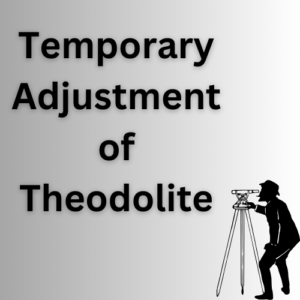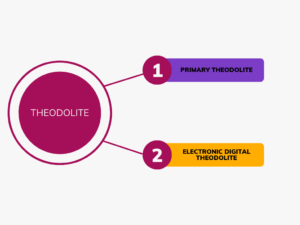What is Theodolite?
A theodolite is an accurate tool used for measuring angles in the vertical and horizontal planes. It is majorly used in construction and surveying to measure angles for layout drawing and mapping. Theodolites combine a telescope mounted on a tripod, with graduated circles and a rotating base for measuring angles.
Temporary Adjustment of Theodolite

Steps of temporary adjustment of theodolite are described below.
- Setting up of theodolite
- Levelling up
- Focusing
Setting up of Theodolite
Spread the legs of the tripod and set the theodolite instrument at a suitable height. Firstly fix the two legs in the field at a point and centering of the bubble tube is done by adjusting the 3rd leg.
Levelling up
The levelling up of the theodolite is done using levelling screws or foot screws. In levelling up, the telescope is adjusted parallel to any two foot screws and the bubble in the levelling tube is centred by turning both screws either outwards or inwards. When the bubble in the bubble tube is centred, then the telescope is turned 90° and the 3rd screw is turned until the bubble comes to the centre of the bubble tube.
Repeat the same procedure until the bubble in the tube always stays at the centre in any position of the telescope.
Focusing
Focusing is done by adjusting focusing screws and eyepiece. Eyepiece is managed until the diaphragm’s cross hairs are clearly visible. To avoid the parallax error, a white paper is used to get sharp vision of cross hairs.
Focusing screws manage to view the clear picture of the staff. Focusing means that when the cross hairs bisect the staff with clear vision.
After completion of temporary adjustment of theodolite, now it is time to take levels of required points. The telescope is rotated in the direction of the staff and bisects it. The levels are marked at different positions whose values are determined from a known benchmark point in that area.
What is Least Count of Theodolite?
Least count of Theodolite is defined as the smallest value that can be measured by theodolite. The least count of theodolite depends on types and model of instrument. For example, the least count of vernier theodolite is 20 seconds and least count of optical theodolite is 1 second.
The least count of theodolite (vernier theodolite) is 20 secs. For various types, the vernier theodolite is less accurate with least count of 20 secs while optical theodolite is more accurate with least count of 1 sec.
In comparison to total station instruments, it is less accurate as the least count for total station is 1 sec. The least count of the surveyor’s compass is 15 mins. The least count of the prismatic compass is 30 mins.
In the below table, comparison of least count of vernier theodolite with optical theodolite, total station, prismatic compass and surveyor’s compass.
| Sr No | Types of Theodolite | Least Count of Theodolite |
| 1 | Total Station | 1 second |
| 2 | Vernier Theodolite | 20 seconds |
| 3 | Optical Theodolite | 1 second |
| 4 | Prismatic Compass | 30 minutes |
| 5 | Surveyor Compass | 15 minutes |
The least count of optical theodolite is 1 sec and thus it is the most accurate theodolite. The other type vernier theodolite has a least count of 20 secs.
Use of Theodolite
Theodolite is majorly used in construction and surveying to measure angles for layout drawing and mapping.
Major uses of theodolite are given below.
- Measuring vertical and horizontal angles.
- Theodolite is used to prepare the layout of building lines and corners.
- To find out the level difference in levelling.
- Theodolite is used to set out the grade on the road.
- Tacheometric survey is done by help of theodolite.
Types of Theodolite
There are different types of theodolite for different objectives of different construction works. Generally, four types of theodolites are used in construction works for different objectives. For example,
- Repeating Theodolite
- Directional Theodolite
- Electrical Digital Theodolite
- Total Station
Theodolite is also classified into the following two types.
- Primary Theodolite
- Electronic Digital Theodolite
Types of Theodolite 1

Repeating Theodolite
A repeating theodolite gauges vertical and horizontal angles on a graduated scale. In repeating theodolite, average reading is taken by dividing total of reading by number of readings taken.
Average reading of theodolite = total of reading / number of reading taken
Generally, a repeating theodolite is utilised in locations where limited space available and where base is unsteady. Repeating theodolite is more accurate than other theodolites because errors are decreased by comparing values of multiple readings in place of a single reading.
Directional Theodolite
Directional theodolites find various angles through a circle. The angle measurements are found by deducting the 1st reading from the 2nd reading. Directional theodolites are generally utilised by surveyors in triangulation survey, which is the process of finding a point by measuring the various angles from known points on a baseline.
Electrical Digital Theodolite
Electrical Digital Theodolite eliminates readings on graduated scales and automatically clarifies and records horizontal and vertical angles.
Total Station
In surveying, total station is defined as the advanced electronic instrument utilised to measure vertical and horizontal angles along with distance.
Types of Theodolite 2

Primary Theodolite
Primary theodolite can be divided into two types.
Transit Theodolite : In transit theodolite, the telescope can be rotated 180° through the horizontal axis in a vertical plane.
Non-transit Theodolite : In non-transit theodolite, the telescope can not be rotated completely through the horizontal axis in a vertical place. Non-transit theodolite can be rotated for a limited angle in the vertical plane.
Electronic Digital Theodolite
This type of theodolite gives the observation by viewing the digital panel. Electronic Digital Theodolite can be divided into two types.
Vernier Theodolite : vernier is installed to measure the angles in the vernier theodolite. Least count of vernier theodolite is 20 seconds.
Micrometre Theodolite : micrometre is installed to measure the angles in the micrometre theodolite. Least count of micrometre theodolites is 1 second.
The electronic digital theodolite is also called Modern Theodolite and functions are given below.
- Measurement of distance
- Measurement of angle
- Storing data
- Process the data
- Display digital data of points.
You May Also Like – Total Station : Benefits and Features